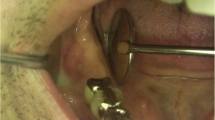Abstract
Background
Osteonecrosis of the jaw (ONJ) is defined by areas of tissue breakdown and exposure of bone in the maxillofacial region that fail to heal within 8 weeks after identification by a health provider in a patient who has not received radiation of the jaws. The disease affects the quality of life and produces significant morbidity in afflicted patients. ONJ is correlated with such risk factors as treatment with bisphosphonates, dental extraction-related trauma, chemotherapy, corticosteroids, renal osteodystrophy and infections. Although the use of bisphosphonates is associated with osteonecrosis of the jaw, the pathophysiology of bisphosphonate-associated ONJ is still unknown. It has been assumed that bisphosphonates lead to the inhibition of capillary angiogenesis and disturbances in the activities of both osteoblasts and osteoclasts, thereby impairing bone remodelling. Currently, inhibitors of angiogenesis used in the treatment of cancer patients are implicated in isolated cases of ONJ.
Case report
This manuscript reports a case of ONJ in a female patient who received bevacizumab (Avastin®, Roche), a humanised monoclonal antibody that recognises and blocks vascular endothelial growth factor (VEGF)-A.
Conclusion
The anti-angiogenic agent, bevacizumab, may increase the risk of osteonecrosis of the jaw. This agent inhibits VEGF and, therefore, also presumably represses the vascularisation of the jaw, which leads to healing complications. Due to increasing use of bevacizumab, patients receiving this agent should be closely monitored for possible side effects.





Similar content being viewed by others
References
Aragon-Ching JB, Ning YM, Chen CC, Latham L, Guadagnini JP, Gulley JL, Arlen PM, Wright JJ, Parnes H, Figg WD, Dahut WL (2009) Higher incidence of osteonecrosis of the jaw (ONJ) in patients with metastatic castration resistant prostate cancer treated with anti-angiogenic agents. Cancer Invest 27:221–226
Marx RE (2003) Pamidronate (Aredia) and zoledronate (Zometa) induced avascular necrosis of the jaws: a growing epidemic. J Oral Maxillofac Surg 61:1115–1117
Disel U, Beşen AA, Özyilkan Ö, Er E, Canpolat T (2012) A case report of bevacizumab-related osteonecrosis of the jaw: old problem, new culpit. Oral Oncol 48:e2–e3
Ngamphaiboon N, Frustino JL, Kossoff EB, Sulllivan MA, O’Connor TL (2011) Osteonecrosis of the jaw: dental outcomes in metastatic breast cancer patients treated with bisphosphonates with/without bevacizumab. Clin Breast Cancer 11:252–257
Hoefert S, Eufinger H (2010) Sunitinib may raise the risk of bisphosphonate-related osteonecrosis of the jaw: presentation of three cases. Oral Surg Oral Med Oral Pathol Oral Radiol Endod 110:463–469
Hopp RN, Pucci J, Santos-Silva AR, Jorge J (2012) Osteonecrosis after administration of intravitreous bevacizumab. J Oral Maxillofac Surg 70:632–635
Guarneri V, Miles D, Robert N, Dieras V, Glaspy J, Smith I, Thomssen C, Biganzoli L, Taran T, Conte P (2010) Bevacizumab and osteonecrosis of the jaw: incidence and association with bisphosphonate therapy in three large prospective trials in advanced breast cancer. Breast Cancer Res Treat 122:181–188
Marx RE, Tursun R (2012) Suppurative osteomyelitis bisphosphonate induced osteonecrosis, osteoradionecrosis: a blinded histopathologic comparison and its implications for the mechanism of each disease. Int J Oral Maxillofac Surg 41:283–289
Sanna G, Preda L, Bruschini R, Cossu Rocca M, Ferretti S, Adamoli L, Verri E, Franceschelli L, Goldhirsch A, Nolè F (2006) Bisphosphonates and jaw osteonecrosis in patients with advanced breast cancer. Ann Oncol 17:1512–1516
Otto S, Schreyer C, Hafner S, Mast G, Ehrenfeld M, Stürzenbaum S, Pautke C (2012) Bisphosphonate-related osteonecrosis of the jaws—characteristics, risk factors, clinical features, localization and impact on oncological treatment. J Craniomaxillofac Surg 40:303–309
Christodoulou C, Pervena A, Klouvas G, Galani E, Falagas ME, Tsakalos G, Visvikis A, Nikolakopoulou A, Acholos V, Karapanagiotidis G, Batziou E, Skarlos DV (2009) Combination of bisphosphonate and antiangiogenic factors induces osteonecrosis of the jaw more frequently than bisphosphonates alone. Oncology 76:209–211
Estilo CL, Fornier M, Farooki A, Carlson D, Bohle G, Huryn JM (2008) Osteonecrosis of the jaw related to bevacizumab. J Clin Oncol 26:4037–4038
Traina TT, Norton L, Drucker K, Singh B (2006) Nasal septum perforation in a bevacizumab-treated patient with metastatic breast cancer. Oncologist 11:1070–1071
Author information
Authors and Affiliations
Corresponding author
Rights and permissions
About this article
Cite this article
Pakosch, D., Papadimas, D., Munding, J. et al. Osteonecrosis of the mandible due to anti-angiogenic agent, bevacizumab. Oral Maxillofac Surg 17, 303–306 (2013). https://doi.org/10.1007/s10006-012-0379-9
Received:
Accepted:
Published:
Issue Date:
DOI: https://doi.org/10.1007/s10006-012-0379-9




